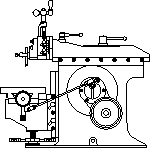

This month’s acquisition and rebuild story is from Eric Lavelle from Belleville, Illinois.
“I really want to use my shaper to make and repair gears for other machines as well as the more standard uses for shapers.
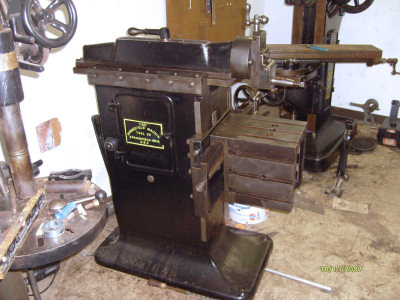
Left
Photo by Eric Lavelle
It all started with an eBay search. Many searches of eBay, classified ads, and auctioneer sites had only shown me shapers which were a thousand miles away and cheap, or really close and really expensive. Finally, there was a listing for a flat belt driven Springfield shaper which was only 250 miles away with a start bid of $50, and was a model first produced in the late 1800s, my era of choice. I waited impatiently for the end of the auction, bid in the last few seconds as usual to avoid both auction fever and other bidders slowly pushing my bid up to the max. All went well, I was the only bidder.
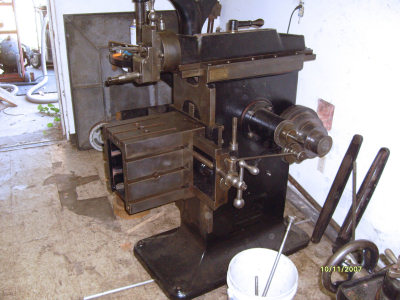
Right
Photo by Eric Lavelle
After a bit of correspondence with the seller, Joe, I set out with my trusty minivan and trailer to retrieve my prize. The drive went well, with none of my previous problems of blowouts, failed trailer bearings, and random intermittent electrical problems. Joe was waiting for me at the front of his garage/shop with an engine hoist to help me load the machine. The old catalog weight was 1550 lbs. which was enough to tip the hoist forward. We walked around his shop grabbing some weights, chucks, etc. to weight down the back of the hoist, and everything went smoothly. I spent some time looking at Joe's various other metalworking machines. He had a nice restored Bridgeport, an old horizontal mill, a small lathe, and one really big lathe in excellent condition. After some good conversation, I strapped down the load and headed for home.

Journey
Photo by Eric Lavelle

Before Left
Photo by Eric Lavelle
The following morning I looked the machine over real well and took pictures of the mechanisms to help with reassembly. There was a good bit of rust on all the exposed machined surfaces. I had already decided I would take it apart right there on my trailer, clean it, paint the parts, then reassemble it after moving it into my metalworking shop.
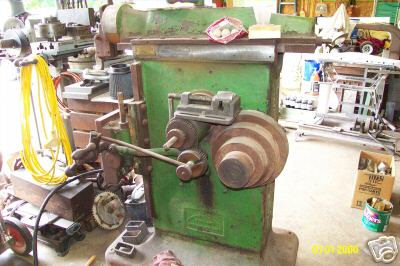
Before Right
Photo by Eric Lavelle
First, I removed the automatic cross feed mechanisms followed by the ram and the table.

Ram
Photo by Eric Lavelle
After that, I carefully and thoughtfully tackled the threaded rod for the table cross feed. The threads on it were rusty, so I cleaned them up to allow it to move without binding on the rust. Next, I carefully examined the collars on the end of the rod, one of which had a set screw in it. The other looked like it was just a spacer. I tapped on them for awhile and finally figured out that even with the set screw, they were both threaded on. After taking those off, I was able to remove the feed rod allowing me to easily remove the saddle. The next order of operations was to remove the cone pulley. The diameter of the shaft on the pulley end was fairly large, which always makes for trouble removing it. The other end simply had a set screw collar on it. Since I didn't have a lead hammer, I took a big babbitt ingot, put a 1½" diameter piece of scrap shaft against the shaft inside the cone pulley and gave it a few good whacks after heating it with a MAPP gas torch. It moved just enough to get a gear puller around the collar on the opposite end.
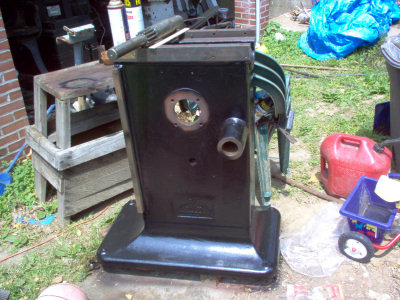
Base Stripped
Photo by Eric Lavelle
It was here that I learned the lesson to take every set screw all the way out of the collar. Instead of just having the set screw against the shaft, they had drilled a hole into the shaft to keep it from moving. I had backed the set screw out quite a bit, but not quite enough. The gear puller shattered the collar. It's a good thing those are readily available stock parts. The carnage allowed me to remove the shaft which still held the cone pulley. I put the shaft through a hole in my workbench, allowing the wide part of the pulley to be supported by the surface of the bench. I hosed it down with penetrating oil, heated it, and used the scrap shaft and a large hammer to drive the shaft through the pulley. The last part of the disassembly was removing the bull gear and the iron rocker arm that drives the ram. The rocker arm pivots on a shaft which was easily removed after loosening some set screws. Once the arm was out, the bull gear came out through the door in the casting.
The great thing about the shaper restoration is that I was able to disassemble it in about 2 days, only ended up with a 5 gallon bucket half full of small parts, and there aren't too many larger parts.
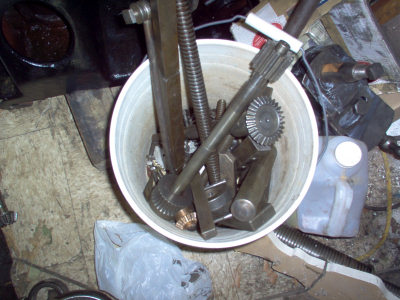
Parts Bucket
Photo by Eric Lavelle
This is a nice change from my Becker Brainard #2 Universal horizontal mill which took me a year to figure out how to disassemble, left me with tubs full of small parts and the floor of a whole room strewn with the larger parts.
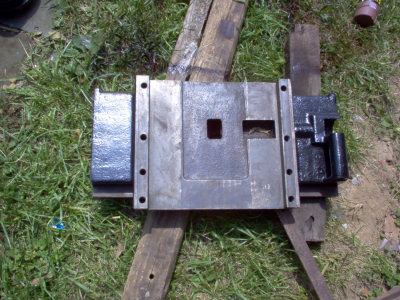
Saddle
Photo by Eric Lavelle
The real nasty part was just beginning. I cleaned all the parts with wire wheels. For the larger castings I used an angle grinder with a knotted wire cup. For small parts I used a bench grinder with a wire wheel. For hard to reach areas, bores, gear teeth, and delicate machined surfaces, I used a drill with various wire wheels and an extension. When there was stubborn rust on machined surfaces, I used the angle grinder with a well worn knotted wire cup gently to avoid taking off any metal.
One of the problems was rusty t-slots. I was about to use electrolysis, but the thought of lifting the table and setting it in the bottom of a trash can tank didn't suit me. Nor did the fact I'd have wet iron when I pulled it out which would need a quick wire brushing anyway. I went down to Ace Hardware and found a 1½" diameter wire wheel. This is a size that they don’t normally carry. The big box stores also don’t usually carry this size wire wheel. It was actually the smallest one I'd ever seen and they only had one. Maybe it came with a box of odds and ends. It was still a little big for the t-slots, so I set it edge up on the workbench and smashed the bristles down with a hammer. After that it fit tightly down the slot and cleaned the rust out very well, very quickly. The info on the packaging that held the wire wheel says Forney Industries, Inc. catalog number 60013. I'm sure any local hardware store could order one, even if they don't normally stock them.
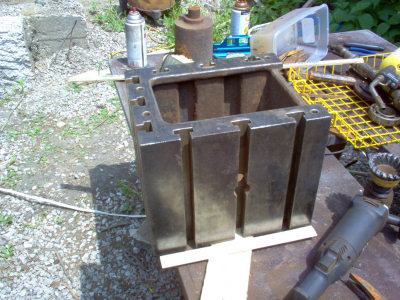
Table
Photo by Eric Lavelle
The cleaning process took several very long and dirty days.
When I got the machine, it was green, but you could see that it had been repainted several times. I decided to use black since it's a period color, matches all the other machines in my shop, and is easy to touch up since I keep a supply of it. I took some time taping the machined surfaces, but not enough time because I got some overspray on parts of it anyway. Oh well, nothing a wire wheel won't fix. I used Rustoleum rusty metal primer and gloss black in spray cans. I use the spray because I can put the top coat over the primer right away, and the whole things dries much faster than brush paint. The gloss is a bit shiny for an old machine, but I find that it cleans easier than other paints.
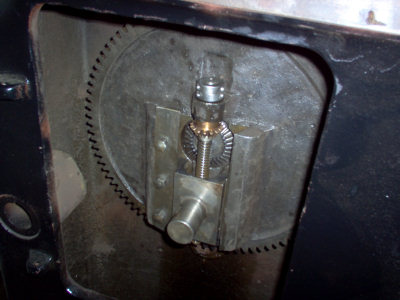
Install Bull Gear
Photo by Eric Lavelle
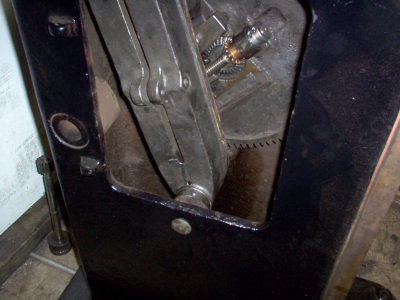
Install Rocker Arm
Photo by Eric Lavelle
Reassembly of the shaper was pretty straightforward. First, I cleaned all the oil ports. Most of them had long been clogged with dirt. Next, I put the bull gear back in, then the rocker arm, the ram, the gearing that operates the auto feed, the cone pulley and shaft, the saddle, and the table.

Install Ram Lead
Screw
Photo by Eric Lavelle
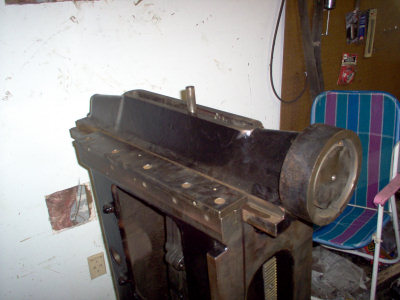
Install Ram
Photo by Eric Lavelle
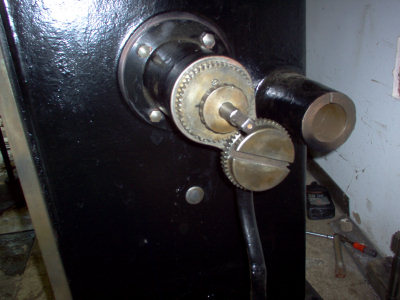
Install Auto Feed
Gears
Photo by Eric Lavelle
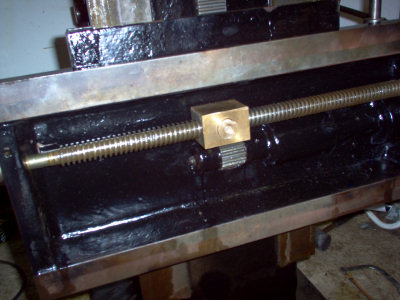
Install Saddle
Photo by Eric Lavelle
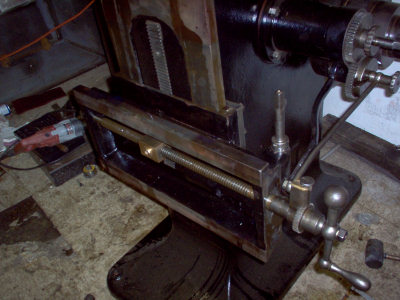
Install Auto Feed
Linkage
Photo by Eric Lavelle
The areas that look slightly rusty on the ways are actually shadows of Rustoleum primer overspray that wouldn't quite brush out. All of the adjustments, frozen before, now operate very smoothly.
It'll be a few months before I actually power it due to the need for a 14ft piece of line shaft.”
Thanks Peter for that great acquisition and rebuild story.
Keep sending me email with questions and interesting shaper stories.
My email address is KayPatFisher@gmail.com.